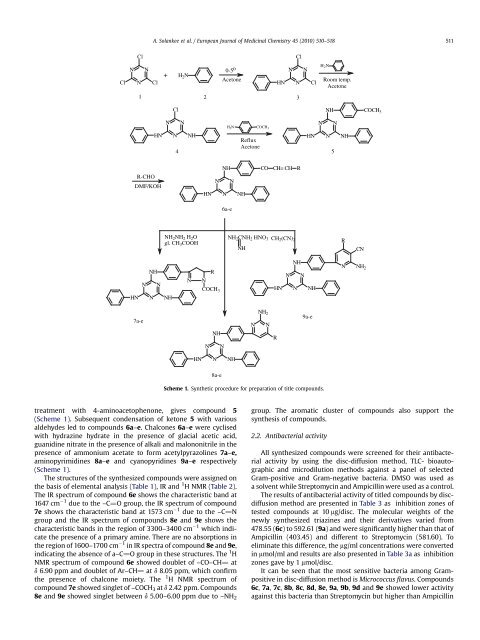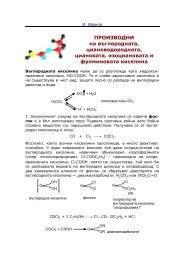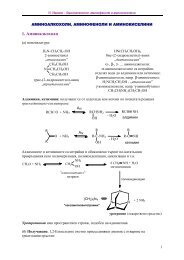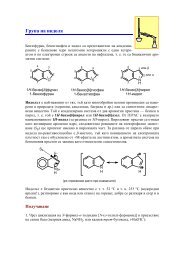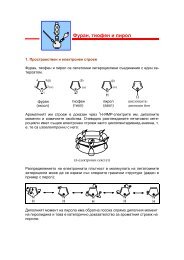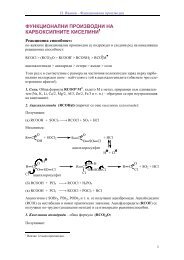Synthesis of some new S-triazine based ... - Ddg-pharmfac.net
Synthesis of some new S-triazine based ... - Ddg-pharmfac.net
Synthesis of some new S-triazine based ... - Ddg-pharmfac.net
Create successful ePaper yourself
Turn your PDF publications into a flip-book with our unique Google optimized e-Paper software.
A. Solankee et al. / European Journal <strong>of</strong> Medicinal Chemistry 45 (2010) 510–518 511<br />
Cl<br />
Cl<br />
Cl<br />
N<br />
N<br />
N<br />
Cl<br />
+ H 2 N<br />
0-5 o<br />
Acetone<br />
HN<br />
N<br />
N<br />
N<br />
Cl<br />
H 2 N<br />
Room temp.<br />
Acetone<br />
1 2 3<br />
Cl<br />
NH COCH 3<br />
N<br />
N<br />
H 2 N COCH 3<br />
N<br />
N<br />
HN<br />
N NH<br />
Reflux<br />
HN N<br />
Acetone<br />
4 5<br />
NH<br />
R-CHO<br />
DMF/KOH<br />
HN<br />
NH CO CH= CH R<br />
N N<br />
N NH<br />
6a-e<br />
NH 2 NH 2 H 2 O<br />
gl. CH 3 COOH<br />
NH 2 CNH 2 HNO 3 CH 2 (CN) 2<br />
NH<br />
R<br />
CN<br />
HN<br />
NH<br />
N N<br />
N<br />
NH<br />
N<br />
N<br />
R<br />
COCH 3<br />
HN<br />
NH<br />
N N<br />
N<br />
NH<br />
N<br />
NH 2<br />
7a-e<br />
N<br />
NH<br />
N<br />
N<br />
NH 2<br />
N<br />
R<br />
9a-e<br />
HN<br />
N<br />
NH<br />
8a-e<br />
Scheme 1. Synthetic procedure for preparation <strong>of</strong> title compounds.<br />
treatment with 4-aminoacetophenone, gives compound 5<br />
(Scheme 1). Subsequent condensation <strong>of</strong> ketone 5 with various<br />
aldehydes led to compounds 6a–e. Chalcones 6a–e were cyclised<br />
with hydrazine hydrate in the presence <strong>of</strong> glacial acetic acid,<br />
guanidine nitrate in the presence <strong>of</strong> alkali and malononitrile in the<br />
presence <strong>of</strong> ammonium acetate to form acetylpyrazolines 7a–e,<br />
aminopyrimidines 8a–e and cyanopyridines 9a–e respectively<br />
(Scheme 1).<br />
The structures <strong>of</strong> the synthesized compounds were assigned on<br />
the basis <strong>of</strong> elemental analysis (Table 1), IR and 1 H NMR (Table 2).<br />
The IR spectrum <strong>of</strong> compound 6e shows the characteristic band at<br />
1647 cm 1 due to the –C]O group, the IR spectrum <strong>of</strong> compound<br />
7e shows the characteristic band at 1573 cm 1 due to the –C]N<br />
group and the IR spectrum <strong>of</strong> compounds 8e and 9e shows the<br />
characteristic bands in the region <strong>of</strong> 3300–3400 cm 1 which indicate<br />
the presence <strong>of</strong> a primary amine. There are no absorptions in<br />
the region <strong>of</strong> 1600–1700 cm 1 in IR spectra <strong>of</strong> compound 8e and 9e,<br />
indicating the absence <strong>of</strong> a–C]O group in these structures. The 1 H<br />
NMR spectrum <strong>of</strong> compound 6e showed doublet <strong>of</strong> –CO–CH] at<br />
d 6.90 ppm and doublet <strong>of</strong> Ar–CH] at d 8.05 ppm, which confirm<br />
the presence <strong>of</strong> chalcone moiety. The 1 H NMR spectrum <strong>of</strong><br />
compound 7e showed singlet <strong>of</strong> –COCH 3 at d 2.42 ppm. Compounds<br />
8e and 9e showed singlet between d 5.00–6.00 ppm due to –NH 2<br />
group. The aromatic cluster <strong>of</strong> compounds also support the<br />
synthesis <strong>of</strong> compounds.<br />
2.2. Antibacterial activity<br />
All synthesized compounds were screened for their antibacterial<br />
activity by using the disc-diffusion method, TLC- bioautographic<br />
and microdilution methods against a panel <strong>of</strong> selected<br />
Gram-positive and Gram-negative bacteria. DMSO was used as<br />
a solvent while Streptomycin and Ampicillin were used as a control.<br />
The results <strong>of</strong> antibacterial activity <strong>of</strong> titled compounds by discdiffusion<br />
method are presented in Table 3 as inhibition zones <strong>of</strong><br />
tested compounds at 10 mg/disc. The molecular weights <strong>of</strong> the<br />
<strong>new</strong>ly synthesized <strong>triazine</strong>s and their derivatives varied from<br />
478.55 (6c) to 592.61 (9a) and were significantly higher than that <strong>of</strong><br />
Ampicillin (403.45) and different to Streptomycin (581.60). To<br />
eliminate this difference, the mg/ml concentrations were converted<br />
in mmol/ml and results are also presented in Table 3a as inhibition<br />
zones gave by 1 mmol/disc.<br />
It can be seen that the most sensitive bacteria among Grampositive<br />
in disc-diffusion method is Micrococcus flavus. Compounds<br />
6c, 7a, 7c, 8b, 8c, 8d, 8e, 9a, 9b, 9d and 9e showed lower activity<br />
against this bacteria than Streptomycin but higher than Ampicillin


